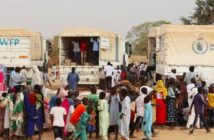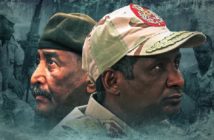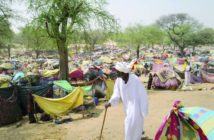What is currently happening in Morocco’s North is the manifest side of the unstoppable rehearsal of the country’s downtrodden?
This rehearsal started with the 20 February movement in 2011 (during the “Arab Spring”), which was mainly spearheaded by the people of theurban centres consumed by desires of distributive justice and democratic change.
The ongoing Hirak Shaabi, or simply the Hirak (popular movement), is a continuity of those burning desires, this time emanating from the Rif, a less urban and more marginalised region, with the word Rif itself denoting countryside.
Distance and clouds
Initially, this geographic distance from the urban centres got even more distant due to an amalgam of factors.
First, the political dominance of the palace-owned Authenticity and Modernity Party (PAM) over Rif made many people think that the whole story is about the PAM mobilising its people.
Second, the absence of the movement’s leaders from the limelight of the national cultural scene led people and activists from the urban centres to show limited solidarity with the movement. For instance, unlike the 20th of February movement, Hirak neither enjoyed the immediate supportof the star association, the Moroccan Association of Human Rights, nor that of the credible and supranational network of activists revolving around it.
Third, since Berber is the language of the everyday in the Rif, the movement’s official language was and still is Berber. This incorrectly led a lot of people as well as the place to think of the movement and its demands as purely regional. Initially, these vague clouds obscured the peaceful identity and legitimate demands of the movement.
But eventually the sky cleared up. The movement proved beyond doubt that it is not backed by the PAM or any other internal or external political entity. Its leaders, though new to Moroccans, showed dexterity in organising, leading, and covering the peaceful protests. They also gradually became aware of the language barrier and smoothly overcame it. Identification and solidarity with the movement at the national level reached its apex in May and June, six months after the eruption of the protests.
Before presenting snapshots of some of the events during this time, let us to first briefly go back to 2011, when collective rehearsals started.
The 2011 rehearsals
As part of its tactics to dilute and coopt the expression of the 20th of February movement, the Moroccan palace launched a series of calculated negotiations with themain actors in the street.
Such acotrs include, though not limited to, labour unions, unemployed graduates, the Amazigh movement, the feminist movement, and many NGOs. As a result of these negotiations, the state significantly increased its budget for the compensation fund, slightly raised the salary of public servants, ceded to a (negligeable) extent to the demands of feminists, provided unemployed graduates with some job offers, and constitutionalised Berber as an official language of the land, pending implementation to this day.
The demand of a constitutional monarchy, in which the king reigns but does not rule, remained the concern of few leftists and other groups of unruly rebels whose voice fell on deaf ears. Their demand was easily swept under the rug.
These actors, in return, stopped the occupation of public spaces.
The newly shuffled government, headed by the royalist Justice and Development Party as a result of the 2012 snap elections, proved nothing more than a cosmetic change in Moroccan politics. The regime eventually dodged democratic reforms by cutting deals and unleashing a series of pseudo-democratic constitutional reforms.
Six years after the fact, standards of living have yet to improve and unemployment is still rampant among young people.
Old wounds
Today, the spectre of freedom, social justice, and dignity—the motto of the 2011 rehearsal—is back to haunt the regime from a region that is historically marginalised and abused by ex-king Hassan II.
The latter attacked the people of the Rif in 1959 and the 1980s, and occasionally described them as riffraff and savages. The wounds from the past have not yet healed, and more from the present have accumulated.
One such wound opened in October 2016. On that day fishmonger Mohsen Fikri, while trying to retrieve his confiscated swordfish, was crushed along with the fish by a garbage truck. A video of the incident spread online like fire in hay, and protests immediately erupted in al-Hoceima and neighbouring villages like Imzouren, giving birth to the Hirak.
The 2017 rehearsals
The Hirak soon found leadership in a host of local young people like unemployed Nasser Zefzafi and singer and university student Sylia Ziani.
Independent newspapers like Rif24and Badil, as well as a plethora of Facebook pages and public figures introduced the Hirak to the wider Moroccan public.
While the early days of public anger were limited to demanding a fully transparent inquiry into the death of Mohsin Fikri, the demands progressively scaled up to an inquiry that is not limited to the people directly involved in the incident. Rather, justice now should go after the people who make the fishing of swordfish during biological rest possible in the first place. The protesters clearly aimed at the resignation of the billionaire and minister of Agriculture and Fisheries Aziz Akhannouch, ideally to be followed by a series of reforms and probes into corruption. But the latter still insists on escaping responsibility, and the fishing industry is still largely corrupt.
The second demand of the Hirak concerns the militarisation of the Rif which originates in a 1958 decree. The protesters insist that the militarisation is continuing, while the government insists that the 1958 decree no longer exists and the militarisation of the region is untrue.
The third demand comprises several economic, social, and cultural rights that the Rif people have been deprived of since the independence in 1956. These include the building of a university, a specialised hospital for treating cancer—it is widely documented that the Spanish used several chemical weapons, including mustard gas, to exterminate indigenous Rifis in the 1920s—and the realisation of economic projects to save the population from the high rate of unemployment.
Instead of responding to these demands, the regime launched a series of arrests in late May that had the majority of the Hirak leaders behind bars, with the total number of political prisoners moving beyond 127 and including protesters, bloggers and leaders. Many political prisoners have alleged police beating already, according to Human Rights Watch and Amnesty International. This change of approach came after a series of state ruses to which the Hirak responded with an unprecedented degree of maturity.
On 11thof May, the government released a statement signed by Prime Minister Saadeddine Othmani, the king-appointed interior minister Abdelouafi Laftit, among other party representatives, accusing the Hirak of separatism as well as of serving foreign agendas by receiving external funding. In response, the18th of May witnessed a large and successful protest against the “separatism” and “foreign agenda” claims. Many protesters quipped that the only separatism there comes from the regime as it tries to separate the movement from its legitimate demands.
Still in al-Hoceima, on the 26th of May, the imam of a mosque used the Friday sermon to accuse the Hirak leaders of fitna, an Arabic word with religious connotations ranging from temptation to sedition and dissension, these being punished by the Moroccan penal code and religious propaganda. Nasser Zefzafi, the icon of the Hirak, seeing that the imamis inciting worshipers to persecute the movement, intervened. Zefzafi made the point that fitna, meaning chaos punished by religion, is to be found elsewhere and not in the movement or among its leaders. Following this intense argument, the Ministry of Islamic Affairs and Endowment released a worded statement accusing Zefzafi, without mentioning his name, of fitna. On the 29th, Zefzafi is arrested for undermining the security of the state, obstructing freedom of worship, among other accusations.
State-sponsored TV channel Al Aoula added to the avalanche of accusations when it depicted the Hirak protesters as vandals despite a 6-month record of peaceful protest. Al Aoula took videos of vandalism in the city that goes back to the 3rd of March when Chabab Rif al-Hoceima played football against Wydad Casablanca and falsely attributed them to the Hirak. The channel has not yet released any statement regarding this misconduct.
There were many responses to these events.
One remarkable response came on Friday 2nd of June when people in al-Hoceima and other neighbouring towns boycotted mosques and, instead, meditated the Friday prayer in the street.
But the strongest response came on Sunday 11th of June from the heart of the capital, Rabat, when Moroccans went to the streets in the biggest protest since 2011, showing massive solidarity with the Rif and reprimanding the state’s heavy-handed approach. Consonant with this, Moroccans abroad staged many solidarity protests, especially in the Netherlands where many “Moroccan Rifis” live. By then, the Hirak’s peaceful identity, tactics, and demands were authenticated by a huge number of citizens.
The system can no longer resort to the empty rhetoric of separatism and external funding.
Currently, the movement, with few leaders remaining in the wild, has changed its list of demands to reflect the current situation. Topping the list of demands now is the immediate release of all political detainees while with drawing any charges against them.
For instance, one recent and rather ridiculous investigation concerns activist Elmortada Iamrachen, who, according to his lawyer Rachid Belaali, is being interrogated on terrorist grounds. Iamrachen has been at the forefront of the movement and is known as a moderate and an unapologetic secular Islamist.
Rehearsals for better negotiations
The protesters learned a great deal from the 20th of February rehearsals.
One such lesson concerns negotiation tactics. After all the fake reforms that the regime launched in 2011, the protesters insist not to negotiate with government officials with little to no legitimacy.
From the beginning, they wanted to negotiate with the king. On April 10th, the palace sent interior minister Laftit, a Rifi himself, to the region to calm down the situation. Laftit was coldly received and had no influence on curbing the uprisings. Following the discourse of the movement’s leaders, one easily understands that key to negotiations is the legitimacy of the negotiating party. If the guarantees given in negotiations are broken, it is the negotiating party’s legitimacy and reputation that will be on stake. Laftit has no legitimacy to lose, nor does the delegation of ministers that visited al-Hoceima on the 18th of May.
Nabil Ahmjik, a close comrade of Zefzafi, told Tel Quel that they were not invited to the meetings held by the delegation and as such did not hand in their demands. Ahmjik is, too, behind bars.
Perhaps collectively detaining the movement’s leaders is a sign of state frustration stemming from the fact that this new wave of leaders is not easy to co-opt. The state is used to cut deals easily. Not anymore.
The activists learned from the past. Currently, they are teaching the future generation.
Rehearsals for the inevitable reforms
Another gain from the 20th of February movement, its most beautiful legacy, is the death of fear.
Fear is gone with the past and the zeitgeist of the time is already defined: reforms more than anything else.
On Sunday the 11th of June, Moroccans chanted “Majesty to the People, Excellency to the People, Long Live the People”. This slogan gained fame in 2011, but, then, corruption out-performed popular voice. In this regard, the state is more advanced than the people. But with the death of fear, people are catching up and the rehearsals continue in rather inventive and brave ways.
During the month of Ramadan, and after the iftar, people resumed the occupation of their cities and villages. To avoid clashing with the police, they would gather on rooftops and shout slogans, or produce a cacophony of sounds with kitchenalia. Police can do nothing about it, and the protests go on.
Another inventive and brave tactic appeared in late Ramadan. Families of the political prisoners were visited by the representatives of the Interior Ministry who pressed them to sign a royal grace request. As such, the king can grant royal grace to the political prisoners during his speech on the occasion of Eid al-Fitr. If he grants royal grace without the political prisoners requesting it, the latter may refuse it on grounds that they did not request it in the first place because they are innocent. That would be embarrassing for the palace. But for the political prisoners, grace means having to declare oneself a criminal, equating the process of peaceful protest with breaking the law. Some families understandably agreed to request royal grace. But many others have not.
Souad Mbark, the wife of the activist Mohamed Jelloul, put it this way to Lakome2: “Why should we request grace while we have committed neither offence nor crime. We cannot apologise for things we have not done. This is unacceptable by god and by law.” This goes on to show that many people involved are politically mature and know full well the rules of the game.
In parallel, state repression is also becoming more inventive.
For instance, the police illegally took saliva samples of the political prisoners. One interpretation is the use of DNA extracted from saliva to frame activists in the future. One fine day next year one might hear in the radio something like this: “This morning Casablanca’s police scientific support unit matched the DNA data gathered at the crime scene with that of a suspect. The latter risks a years-long sentence.”
*
* *
What we see in Morocco ever since the beginning of this decade is an incessant labour of the people to better their living standards.
People are starting to feel entitled to using public space, occupying it whenever that serves their interests.
This constant entitlement of space and performance of collective action are rehearsals for something bigger. For the future, a bigger step would be the forceful institutionalisation of these movements by garnering support from the huge base of the downtrodden. The ruling elites must be forced to cede power. On the other hand, the palace still shies away from democratic reforms and distributive justice. In the past, whenever reforms were gained by protest they were rolled back soon after the protest died down.
The 2017 rehearsals mean that it is high time this changed. Dealing in dubious guarantees, sharing wealth and cutting deals with select few, and going after hot heads when the streets get quiet will not deliver people from the brunt of poverty.
Framing and imprisoning protesters and repressing public anger instead of delivering the much-needed socio-economic and political reforms is a nasty exercise in brinkmanship that is destined to go awry sooner or later.





